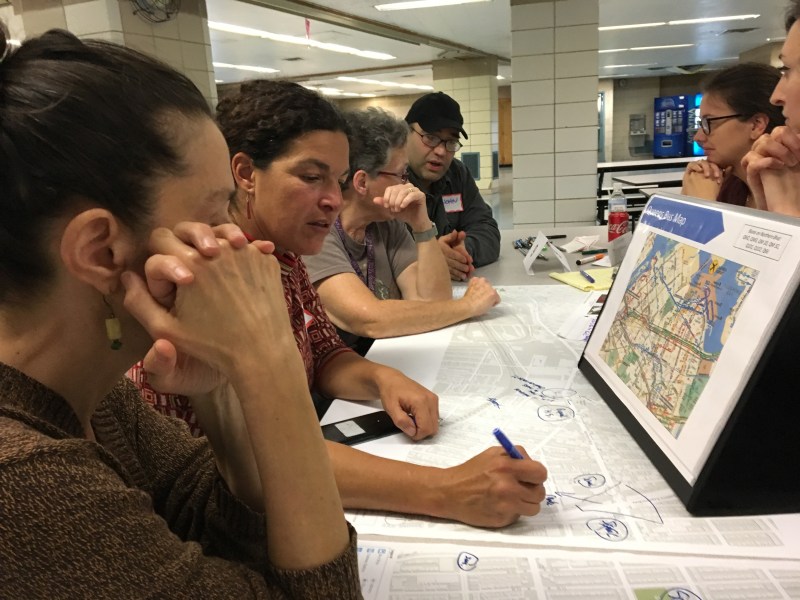Public to DOT: Give Us Safety On Northern Boulevard
Residents met Monday to discuss the future of the "New Boulevard of Death."

Dozens of street safety advocates and plenty of their fact-averse foes agreed on Monday night that substantial changes need to be made to improve Northern Boulevard — even at the expense (yes, you are reading this right) of drivers.
Eight pedestrians have been killed on the so-called “New Boulevard of Death” between the Grand Central Parkway and Queens Plaza since 2012, with hundreds more injured, so the city is convening workshops to build consensus for a redesign similar to the life-saving effort on Queens Boulevard.
The Department of Transportation did not say when it will create a final design, but if the agency is listening to residents, the final plan will create greater walkability and safety for pedestrians, even at the expense of drivers. And maybe even some play streets and greenery.
“If a place is beautiful, people don’t rush through it,” Jackson Heights resident Molly Felde said.

Despite longstanding battles between pedestrian and cycling advocates and some car-centric neighborhood residents, the severity of the problem on Northern Boulevard has encouraged even opponents of other street safety projects — such as Assembly Member and Vision Zero critic Michael DenDekker — to support changes beyond some gradual tweaks DOT has made over the years.
“One of the things that we want to stop is having the DOT come back every year and look at this and still not have the ability to get it right,” said Council Member Francisco Moya, who has opposed street safety improvements along 111th Street, and opposes an initiative known as “Clear Curbs” that reduces double-parking.
At Monday night’s meeting, attendees gathered around cafeteria tables at Louis Armstrong Middle School to draft lists of priorities. Some drew inspiration from the DOT playbook and endorsed longer leading pedestrian intervals, curb extensions, wider sidewalks, and the speedy implementation of more pedestrian refuge islands.
DOT has installed 13 pedestrian islands since 2014, and will install 10 more between 70th and 92nd streets within the next two years. The islands have decreased pedestrian injuries by 51 percent and reduced injuries to all road users by 19 percent. More than half of the crashes that harmed pedestrians were caused by drivers who failed to yield to pedestrians in the crosswalk.
But some see them as half measures. Greater safety will come from reduced speeding on the notorious raceway, better enforcement of bus lane parking restrictions and, more controversially, a protected bike lane.

“I don’t bike much because I find it unsafe and I’m not willing to risk it with two young children,” said Jackson Heights resident Dennis Hernandez. “I would bike if there was a protected lane. It’s an ideal route that connects to the 59th Street Bridge.” Hernandez’s table declared itself in favor of “safety first, even at the expense of taking out a lane of traffic,” but not everyone agreed.
“Bike lanes are too risky on Northern Boulevard,” said Manny Perez, presenting for his table. “It’s a busy street.”
It is a busy street, which is why DOT is hoping to mollify it. The agency’s toolkit includes a proven strategy called a road diet that removes a lane of car traffic, or narrows existing lanes, to reduce speeds. DOT did such a redesign on Queens Boulevard, which used to be known as The Boulevard of Death. Since the redesign, no pedestrians or cyclists have died, down from 195 between 1990 and 2015.
“People see the design and that it is saving lives,” DOT Queens Commissioner Nicole Garcia said, referring to Queens Boulevard. “Northern Boulevard is a different street. There’s no other one like it, in terms of it’s geometry, uses, community. What we went through with Queens Boulevard will not make this easier, they’re just different.”
But similar in one way: There is universal support for change.
“Northern Boulevard was always unsafe when I was growing up,” said Corona resident Brian Zumba, 22. “It’s just not safe for people who want to walk there and the people who live here. This is a good opportunity to change that.”
To add your voice, visit DOT’s online feedback portal or attend one of two upcoming workshops on Monday, Oct. 22 at PS 151, 50-05 31st Ave.; or on Monday, Oct. 29 at PS 166, 33-09 35th Ave. Both are at 6:30 p.m.
